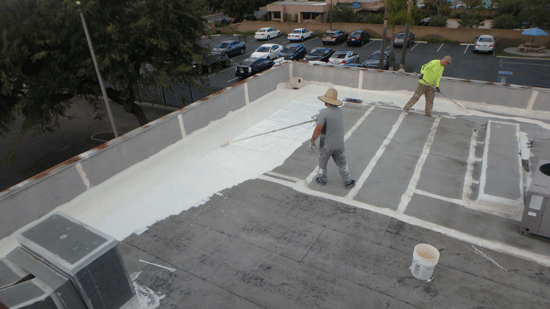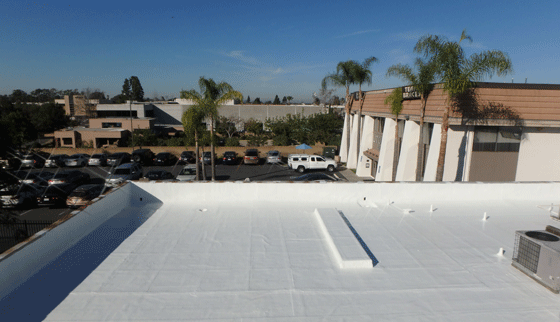With more than 250 sunny days each year, the city of San Diego, California, is renowned for its mild climate and beautiful weather. But all that “fun in the sun” can take a toll on anyone or anything with constant exposure — and that’s especially the case with older, darker roofs.
For equipment supplier Audio Video Supply, Inc. (AVS), the sun’s ultraviolet (UV) rays had become a major concern. Located two hours down the Pacific coast from Hollywood, its main San Diego store had a 10,000 square foot (929.0 m2) commercial mineral cap roof installed nearly 20 years ago, and AVS was concerned about the “heat sink” effect associated with older types of coatings such as asphalt. The roof had some areas bare of aggregate, with others showing fiber. Multiple areas of capsheet separation were present, along with failing acrylic repairs.
To address this, AVS wanted the environmental benefits of a zero-VOC (volatile organic compound) coating combined with enough system durability to require little to no maintenance for extended periods. Fortunately for the client, one local coatings contractor had an innovative solution in mind to combine a traditional white silicone with a novel gypsum material.
Developing a Plot
Marcelo Ruiz, president and CEO of San Diego Roofing, Inc., didn’t have a previous relationship with AVS, but the two sides bonded quickly when the client saw what the roofers proposed. “We didn’t know the client before,” Ruiz said. “We were connected very organically through our website. They had made an inquiry when doing a search for commercial roof. We went out there, they got a few bids, and the end result was that the warranty that we were going to be able to offer was stronger than any other warranty they were getting feedback on.”
The secret to the proposal was the use of Ecodur 201R in tandem with Gaco Western silicone coatings. Manufactured by Castagra, Ecodor 201R’s primary ingredients are castor oil and gypsum, making it one of the more environmentally friendly roof coatings on the market. The product is completely non-toxic and has double the adhesion of most conventional epoxy coatings, according to the manufacturer. San Diego Roofing has seen increased interest in the system based on its results.
“We like Ecodur because of its adhesion to any surface that we would encounter on a roof,” Ruiz explained. “It is able to molecularly bond through the surface and into the pores of whatever it is that we’re coating. We were going over a mineral cap, and Ecodur actually penetrates the surface to a point where the Ecodur and the capsheet are no longer separable.”
Because the system is zero-VOCs, there were no hazardous fumes for the client to be concerned with. That was a huge priority here, since AVS wanted to remain open to customers throughout the week-long project. “They wanted the type of system that would be least disruptive to day-to-day business,” Ruiz said. “With this, we did not have to remove a roof layer. We were able to start waterproofing immediately.”
Though weather was ideal on this project in January 2018, Ruiz said another Ecodur system benefit is the flexibility it provides in case of rainy days. “It waterproofs as soon as it is applied,” he explained. “Whatever you were able to coat before the rain, it stays.”
High Production Value
Due to high parapets and a stairwell to the roof, safety concerns were minimal for the three-person roofing crew. Personal protective equipment (PPE) consisted of gloves and eye protection from 3M, long sleeves, and pants — with the latter largely for cosmetic purposes.

“The Ecodur is inert, but it sticks to everything and can take a week or two to wash off skin,” Ruiz said. “It will not wash off clothing. It’s not corrosive, but it adheres itself to your skin. It would just be very inconvenient to walk around with Ecodur. It’s not going to hurt you, but it’d just be embarrassing to have it all over you!”
There were some heating, ventilation, and air conditioning (HVAC) units that needed to be disconnected and moved as part of preparation work, which the crew did by placing them on rollers and moving them to areas where they were not working. Working in segmented daily portions, the crew prepared the roof’s surface by removing any loose previous repairs, scraping any brittle asphalt, thoroughly sweeping, wire-brushing any spots of deep dirt, and then blowing the area with Echo leaf blowers.
Each member of the three-person crew had a distinct job when applying, with one mixing parts A and B in a double-auger mixer; another dumping the product and squeegeeing it onto the roof with 24-inch (61.0 cm) squeegees with 3/8-inch (1 cm) notches from Seymour Midwest; and the third bringing buckets to the person mixing and to the spreader, as well as moving any equipment or other items that might be in the way.
“If things ever get out of sync, they just finish the bucket they’re on, take a break, and get right back in,” Ruiz said. “It works very well with a three-man crew, it’s hard to get too far out of sync. They’re very reliant on each other.”
The crew first mixed partial kits of Ecodur for brush work on all penetrations and detail areas, owing to the 40-minute pot life. Where there were unique transitions around staircases, the crew used fumed silica to thicken the Ecodur to a “peanut butter-ish consistency,” Ruiz explained. “That makes it stand and fill gaps very well.”
After those were completed, they mixed full kits and dumped quarter- to half-buckets of Ecodur at a time before squeegeeing and backrolling to a wet film thickness (WFT) of 40–50 mils (1,016.0–1,270.0 microns). “The squeegee and backroll method makes the 40-minute pot life easy to manage,” Ruiz said. Meanwhile, the GacoFlex E5320 epoxy primer was applied at 6–8 mils (152.4–203.2 microns) WFT on taller parapets because the crew was still working out how to effectively use the Ecodur in those situations. “We always say ‘thin to win’ with the epoxy primer,” Ruiz added.
After the Ecodur or primer cured overnight, the crew came back the next day for each area and applied the GacoFlex SeamSeal SF2000 to vertical seams at an average of 24 mils (609.6 microns) and the GacoFlex S2100 to all other areas at an average of 32 mils (812.8 microns), again by squeegeeing and backrolling. “The SF2000 is a flashing compound for areas where we needed to fill larger gaps,” Ruiz explained. “If we’re sealing a penetration, that product is going to go on thicker right at the penetration. The actual surface is the S2100, which gives it a longer-term reflectivity value.”
Post-application inspections revealed no anomalies, and after just one week, the San Diego Roofing crew departed the jobsite on schedule.
Supporting Cast
For AVS, it’s the combination of the silicone with the gypsum that should ultimately produce success. “[Silicone] works great, but on any kind of commercial roof, you’re going to have traffic, and what that Ecodur does is give the silicone a fighting chance. If they drop some piece of equipment that penetrates the roof, they can easily penetrate the silicone, but not the Ecodur,” Ruiz said.
The San Diego Roofing crew anticipates a triumphant jobsite return at the one-year mark. “They’re happy,” Ruiz said of the client. “Our one-year anniversary is coming up, so we’ll be out there just to do a walkthrough and see how it’s doing, and we expect everything to look just the way we left it.”
For the video supply client, one might even consider this roof an award-worthy picture, and the crew a best supporting cast!
